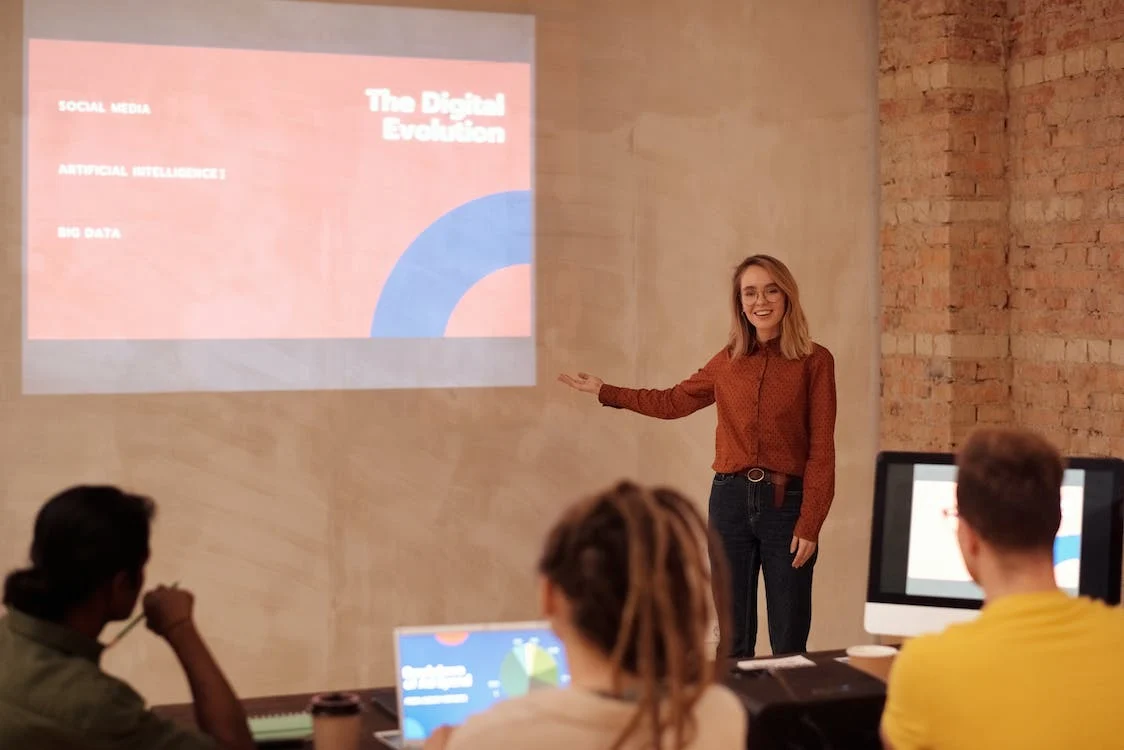Welcome to our guide, a valuable resource for students, educators, and professionals aimed at improving their project presentation skills. Effective presentations are more than just a skill; they are a key part of academic success, fostering clear communication, critical thinking, and the ability to influence and inform. This guide provides essential tips and strategies for preparing compelling presentations, complete with key templates for structure and clarity. Whether you’re presenting a thesis, a group project, or a research proposal, our insights will help you convey your ideas effectively and make a lasting impact.
Let’s start a journey to elevate your presentation skills and unlock the benefits they bring to your academic and professional endeavors!
10 tips for your project presentation
Dive into our focused tips for project presentations. This section offers 10 practical strategies to elevate your delivery. Learn how to prepare an impactful title, engage your audience effectively, and much more. Each tip is tailored to help you present your ideas in a clear, persuasive manner, confirming your presentation stands out.
1. Start with a striking title
The first step in a successful project presentation is to grab attention with a striking title. A well-chosen title can spark the audience’s interest and set the tone for your presentation. It acts as a sneak peek, providing a hint of what to expect and helping to guide the audience’s expectations.
For example, consider the titling approach for a presentation about an innovative recycling program:
- Instead of a straightforward title like “Recycling Initiative,” choose something more engaging: “Revolutionizing Waste: Our Journey to a Greener Tomorrow.” This kind of title not only attracts your audience but also clearly communicates the central message and goals of your project.
2. Identify your audience
Understanding and tailoring your project presentation to your audience is crucial for effective communication.
Using the topic “Revolutionizing Waste: Our Journey to a Greener Tomorrow” as an example:
- Academic focus. When presenting to classmates or in an academic setting, focus on the project’s relevance to your studies, its innovative approach to waste management, and its potential impact on the environment. Highlight how it relates to the courses you are taking or the broader educational goals of sustainability.
- Community relevance. If your audience includes local community members or school administrators, highlight the practical applications of the project, such as how it can improve local waste management practices or contribute to the community’s environmental health. Explain its benefits in a way that resonates with their daily lives and community values.
- Economic appeal for sponsors. In situations where you’re presenting to sponsors or external parties, highlight the economic advantages and the ability for innovation in sustainable waste management. Show how the project unites with broader market trends and can offer practical solutions for waste management challenges.
By tailoring your presentation to match the interests and concerns of your specific audience, whether they are other students, community members, or outside groups, you improve the effectiveness of your communication. This approach ensures that your project presentation on “Revolutionizing Waste: Our Journey to a Greener Tomorrow” is engaging, informative, and impactful for whoever is listening.
3. Anticipate and prepare for challenging questions
Being ready for challenging questions during a project presentation is key to demonstrating your credibility and showcasing your expertise. It demonstrates that you’ve thought deeply about your project and are knowledgeable about its details.
- Expect difficult questions. Prepare by considering possible challenging questions and collecting relevant information to respond confidently and accurately. This preparation involves a deep understanding of your project’s goals, methods, and strategies.
- Support answers with evidence. Back up your answers with solid evidence like data, case studies, or real-world examples that support your points. This approach not only adds weight to your responses but also demonstrates your thorough research and understanding.
- Stay calm and confident. Practice responding to these questions calmly and confidently. It’s important to keep calm under pressure, which gives confidence in your project and its values.
By being well-prepared for any challenging questions, you not only strengthen your presentation but also improve your ability to engage with your audience effectively and convincingly.

4. Show flexibility and adaptability
Being flexible and adaptable is crucial when dealing with unpredictable situations in a project presentation, such as unexpected questions or technical issues. It’s important to:
- Prepare for a range of scenarios. Expect and plan for different possibilities that could arise during your project presentation. This preparation can include having backup plans for technical difficulties or preparing for various audience questions.
- Adapt on the fly. Demonstrate your ability to modify your project presentation approach as needed. This could mean changing your speaking style based on audience engagement, skipping certain sections if time is constrained, or explaining more about topics that attract more interest.
By demonstrating flexibility and adaptability, you not only manage unexpected situations more effectively but also show your audience that you are capable and confident, no matter what challenges arise during your presentation.
5. Tell a story in your project presentation
Transform your project presentation into a compelling story to deeply engage your audience. Take our frequently discussed example, ‘Revolutionizing Waste: Our Journey to a Greener Tomorrow,’ and consider the following storytelling approach:
- Begin with the current situation. Explain the challenges with waste management, the issue of pollution, and the global need for sustainable practices. Create a striking backdrop that underscores the urgency of these issues.
- Highlight your project as a solution. Describe how “Revolutionizing Waste” brings innovative answers to these problems. Discuss its role in improving recycling efforts, reducing waste in landfills, and aiding environmental protection.
- Share real-life impacts. Tell stories of communities or environments positively changed by practices your project promotes. These narratives can illustrate the real benefits of your project, promoting it beyond a theoretical concept.
Using storytelling in your project presentation not only makes complex subjects clearer but also motivates your audience to join in your effort for a more sustainable future.
6. Incorporate storytelling methods
Employing storytelling techniques is important in any project presentation, as it serves as an effective way to attract and build a connection with your audience. These methods can:
- Simplify complex ideas. By incorporating your information into a story, you make complex or technical details more accessible and easier for your audience to understand.
- Make the presentation memorable. Stories tend to stick in our minds longer, guaranteeing that your audience will remember the key points of your presentation long after it’s over.
Using these storytelling methods not only makes your presentation more engaging but also improves the overall impact of the information you are sharing.
7. Discuss the challenge and resolution
In any project presentation, it’s crucial to address the challenge at hand and provide a clear resolution. This approach not only sets the context but also underlines the importance of your project to the audience. Then, showcasing a concrete solution demonstrates the direct impact of your project in resolving the issue.
Using our theme “Revolutionizing Waste: Our Journey to a Greener Tomorrow” as an example:
- Begin by detailing the challenge. Describe the severe issue of waste accumulation and its effects on both the environment and society. For instance, talk about the escalating problem of landfill overflow and its harmful impacts on ecosystems and community health.
- Present your project as the solution. Introduce “Revolutionizing Waste” as a holistic approach to address these challenges. Explain how the project incorporates innovative recycling methods, waste reduction strategies, and public understanding campaigns to promote a sustainable future. Share success stories or case studies where similar methods have made a significant difference.
Effectively laying out the problem and your project’s solution not only highlights the urgency but also illustrates the practical impact of your work, engaging your audience and encouraging their support for a mission that benefits the community and the environment.
8. Incorporate graphics and visuals for data
In your project presentation, especially for themes like “Revolutionizing Waste,” using graphics and visuals to present numerical data can significantly improve understanding and engagement. Visual aids transform complex data into a format that’s easier for your audience to summarize. Consider this application in your project presentation:
- Visualizing progress with line graphs. Use line graphs to illustrate the reduction in waste over time, showcasing your project’s effectiveness. This visually demonstrates both progress and impact.
- Resource allocation with pie charts. To display how resources or funds are used, employ pie charts. They provide a clear visual breakdown, simplifying the understanding of resource distribution.
- Highlight key data with captions and markers. Use them to point out critical figures and landmarks in your data. This approach not only draws attention to important statistics but also helps in storytelling.
Using visuals to present data in your project makes your content clear and interesting. This method turns hard-to-understand data into something easy to learn, adding excitement to your presentation. Visuals like charts and graphs help your audience quickly understand important data, making your project’s results more relatable and easy to follow.
9. Concentrate on the design
In your project presentation, the design significantly influences how your audience interacts and engages with your content. Paying attention to design elements can create slides that are not only visually attractive but also effective in communication. Key design aspects to consider:
- Consistent color scheme. Opt for a color scheme that matches your project’s theme. For environmentally-focused presentations like “Revolutionizing Waste,” green and earth tones are ideal.
- Readable fonts for accessibility. Select fonts that are easy to read and inclusive for all audience members. Clear, readable fonts ensure that your message is accessible.
- Thoughtful content placement. Put your content in a logical, visually attractive layout. A well-organized presentation helps guide your audience smoothly through your points.
- Effective use of white space. Use it strategically to improve readability and prevent your slides from appearing too crowded.
By focusing on these design aspects, you improve the overall clarity and impact of your project presentation, making it more memorable and attractive for your audience.
10. Have a clear call to action
Ending your project presentation with a clear call to action (CTA) is essential. It directs your audience on what to do next, enhancing the impact of your presentation.
For example, in a project presentation on “Revolutionizing Waste: Our Journey to a Greener Tomorrow,” your call to action could be structured as follows:
- Join our mission to transform waste management: Start by implementing sustainable recycling practices in your community.

Templates that you can include in your project presentation
After exploring our 10 practical tips to improve your project presentation, let’s delve into another crucial aspect: structuring your content effectively. Using well-structured templates is key to organizing your presentation and ensuring your ideas are communicated clearly and impactfully. Here are some essential templates to consider including in your presentation:
- Project overview. This template should succinctly summarize the project’s purpose, scope, and objectives. It’s an excellent way to introduce your audience to the project and provide a clear context.
- Timeline and milestones. Use this to visually represent the project timeline, including key milestones and deadlines. It helps in illustrating the project’s progression and important dates or phases.
- Problem and solution. This template is crucial for clearly explaining the problem your project addresses and outlining the proposed solutions. It should highlight the need for the project and how it plans to resolve or improve the situation.
- Data and analysis. When presenting data and analysis, a well-organized template can help in making complex information easier to understand. Include charts, graphs, and infographics to effectively convey your data.
- Case studies or personal stories. If relevant, include real-life examples or personal stories that support the validity and success of your project. This can add credibility and a practical perspective to your presentation.
- Budget and resource planning. This is important for projects with major financial or resource needs. Clearly show the budget details, how resources are used, and any financial predictions.
- Team and roles. Introduce your team and outline the roles and responsibilities of each member. This helps in humanizing the project and showcasing the expertise behind it.
- Future plans and projections. Provide insights into the future trajectory of the project, including any long-term goals or upcoming steps. This is especially important for projects that are ongoing or can be developed.
- Q&A or feedback session slide. Reserve a template for a Q&A or feedback session at the end of your presentation. This inspires audience interaction and shows openness to discussion and feedback.
- Call to action slide. Conclude your presentation with a clear call to action. What do you want your audience to do after your presentation? This slide should motivate and direct the audience towards the desired action or response.
Incorporating these templates into your project presentation guarantees that you cover all critical aspects of your project in an organized and engaging way. They provide a framework that helps you to communicate your ideas clearly and effectively, making a lasting impression on your audience.

Handling audience feedback and interaction
As a key final aspect of your project presentation, effectively managing audience feedback and interaction can greatly enhance the overall impact. This approach guarantees your presentation’s effectiveness grows beyond just the delivery. This section offers guidance on several key areas:
- Encouraging audience participation. Explore ways to entertain your audience during the presentation, including optimal timing for Q&A sessions, encouraging participation from all audience members, and addressing various types of questions.
- Responding to feedback. Learn how to professionally respond to both positive and negative feedback, use critiques to improve, and include feedback to make future presentations better.
- Ensuring originality in your presentation. To ensure the authenticity and uniqueness of your presentation content, consider using our plagiarism-checking service. It’s a vital step in preserving academic integrity and can help improve the professionalism of your work. For support in creating an original and impactful presentation, our platform is ready to assist you.
- Connecting with the audience after the presentation. Discover strategies for keeping audience engagement after your presentation. This can involve arranging follow-up meetings, providing extra resources, or setting platforms for continued dialogue.
- Using feedback for project improvement. Discover how to use audience feedback to improve and grow your project, understanding that audience insights are a valuable resource for ongoing project development.
This section completes our guide by underscoring the importance of audience engagement, both during and after your presentation, demonstrating the full spectrum of effective project presentation skills.
Conclusion
| This guide prepares students, educators, and professionals with strong skills for unique project presentations. Covering everything from preparing engaging titles to effective audience interaction, it offers a wide approach to creating impactful and persuasive presentations. The guide’s focus on structured templates guarantees that your content is both well-organized and clearly communicated. The importance of connecting with the audience after the presentation is also emphasized, showing how each session is a chance for learning and improving your project. With these insights, you’re well-prepared to deliver presentations that are informative, memorable, and influential. Start your journey to master project presentations with this article, and turn every chance into a display of knowledge, interaction, and inspiration. |
